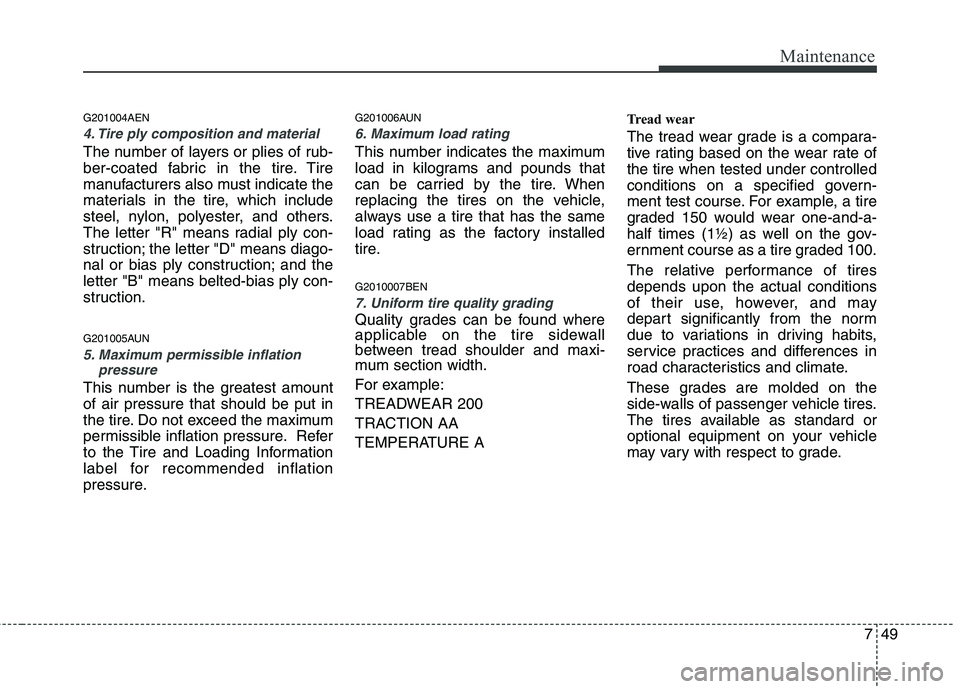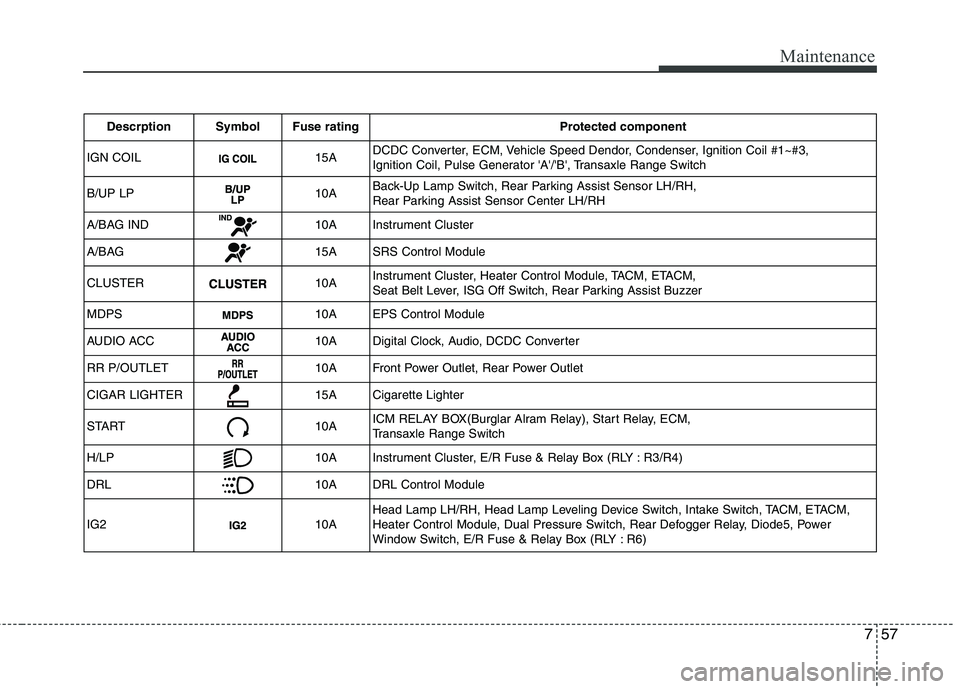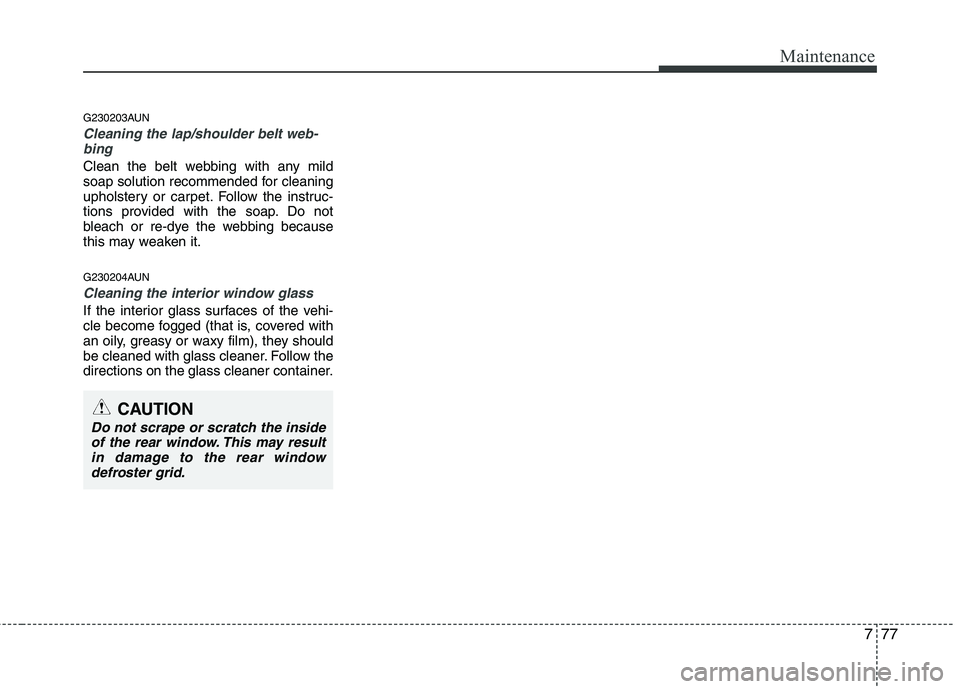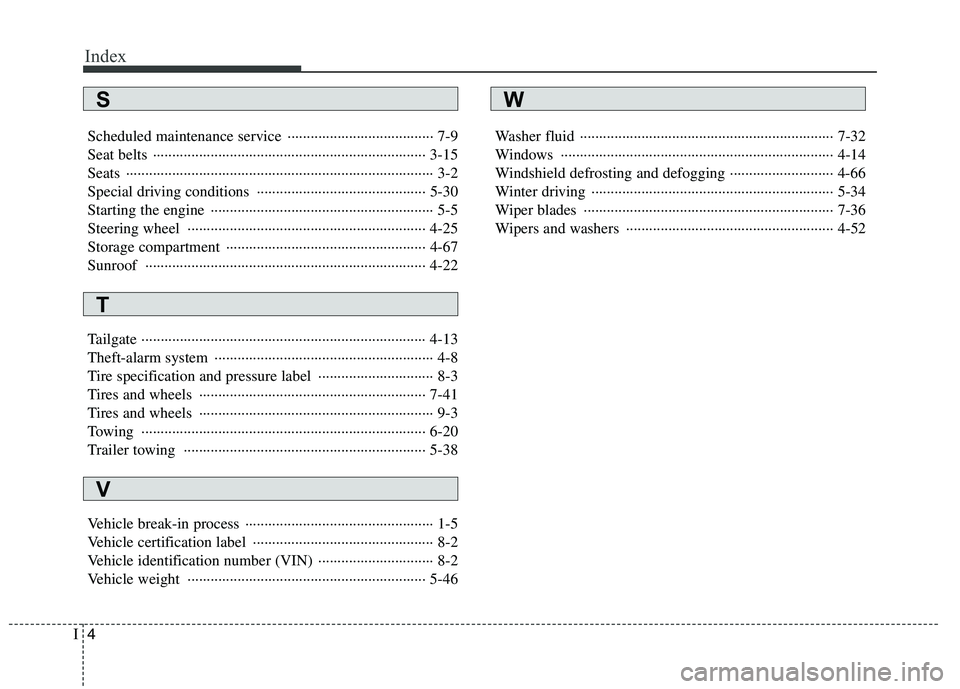belt HYUNDAI I10 2010 Repair Manual
[x] Cancel search | Manufacturer: HYUNDAI, Model Year: 2010, Model line: I10, Model: HYUNDAI I10 2010Pages: 354, PDF Size: 37.04 MB
Page 311 of 354

749
Maintenance
G201004AEN
4. Tire ply composition and material
The number of layers or plies of rub-
ber-coated fabric in the tire. Tire
manufacturers also must indicate the
materials in the tire, which include
steel, nylon, polyester, and others.
The letter "R" means radial ply con-
struction; the letter "D" means diago-
nal or bias ply construction; and theletter "B" means belted-bias ply con-
struction.
G201005AUN
5. Maximum permissible inflationpressure
This number is the greatest amount of air pressure that should be put in
the tire. Do not exceed the maximum
permissible inflation pressure. Refer
to the Tire and Loading Information
label for recommended inflation
pressure. G201006AUN
6. Maximum load rating
This number indicates the maximum
load in kilograms and pounds that
can be carried by the tire. When
replacing the tires on the vehicle,
always use a tire that has the same
load rating as the factory installed
tire. G2010007BEN
7. Uniform tire quality grading
Quality grades can be found where
applicable on the tire sidewall
between tread shoulder and maxi-
mum section width.
For example:
TREADWEAR 200
TRACTION AA
TEMPERATURE A
Tread wear
The tread wear grade is a compara-
tive rating based on the wear rate ofthe tire when tested under controlled
conditions on a specified govern-
ment test course. For example, a tire
graded 150 would wear one-and-a-
half times (1½) as well on the gov-
ernment course as a tire graded 100.
The relative performance of tires depends upon the actual conditions
of their use, however, and may
depart significantly from the norm
due to variations in driving habits,
service practices and differences in
road characteristics and climate.
These grades are molded on the
side-walls of passenger vehicle tires.
The tires available as standard or
optional equipment on your vehicle
may vary with respect to grade.
Page 319 of 354

757
Maintenance
Descrption Symbol Fuse ratingProtected component
IGN COIL
15A DCDC Converter, ECM, Vehicle Speed Dendor, Condenser, Ignition Coil #1~#3,
Ignition Coil, Pulse Generator 'A'/'B', Transaxle Range Switch
B/UP LP
10A Back-Up Lamp Switch, Rear Parking Assist Sensor LH/RH,
Rear Parking Assist Sensor Center LH/RH
A/BAG IND
10A Instrument Cluster
A/BAG
15A SRS Control Module
CLUSTER
10A Instrument Cluster, Heater Control Module, TACM, ETACM,
Seat Belt Lever, ISG Off Switch, Rear Parking Assist Buzzer
MDPS
10A EPS Control Module
AUDIO ACC
10A Digital Clock, Audio, DCDC Converter
RR P/OUTLET
10A Front Power Outlet, Rear Power Outlet
CIGAR LIGHTER
15A Cigarette Lighter
START
10A ICM RELAY BOX(Burglar Alram Relay), Start Relay, ECM,
Transaxle Range Switch
H/LP
10A Instrument Cluster, E/R Fuse & Relay Box (RLY : R3/R4)
DRL
10A DRL Control Module
IG2
10A Head Lamp LH/RH, Head Lamp Leveling Device Switch, Intake Switch, TACM, ETACM,
Heater Control Module, Dual Pressure Switch, Rear Defogger Relay, Diode5, Power
Window Switch, E/R Fuse & Relay Box (RLY : R6)
Page 339 of 354

777
Maintenance
G230203AUN
Cleaning the lap/shoulder belt web-bing
Clean the belt webbing with any mild
soap solution recommended for cleaning
upholstery or carpet. Follow the instruc-
tions provided with the soap. Do not
bleach or re-dye the webbing because
this may weaken it.
G230204AUN
Cleaning the interior window glass
If the interior glass surfaces of the vehi-
cle become fogged (that is, covered with
an oily, greasy or waxy film), they should
be cleaned with glass cleaner. Follow the
directions on the glass cleaner container.
CAUTION
Do not scrape or scratch the inside
of the rear window. This may resultin damage to the rear window defroster grid.
Page 354 of 354

Index
4
I
Scheduled maintenance service ······································ 7-9
Seat belts ······································································· 3-15
Seats ················································································ 3-2
Special driving conditions ············································ 5-30
Starting the engine ·························································· 5-5
Steering wheel ······························································ 4-25
Storage compartment ···················································· 4-67
Sunroof ········································································· 4-22
Tailgate ·········································································· 4-13
Theft-alarm system ························································· 4-8
Tire specification and pressure label ······························ 8-3
Tires and wheels ··························································· 7-41
Tires and wheels ····························································· 9-3
Towing ·········································································· 6-20
Trailer towing ······························································· 5-38
Vehicle break-in process ················································· 1-5
Vehicle certification label ··············································· 8-2
Vehicle identification number (VIN) ······························ 8-2
Vehicle weight ······························································ 5-46 Washer fluid ·································································· 7-32
Windows ······································································· 4-14
Windshield defrosting and defogging ··························· 4-66
Winter driving ······························································· 5-34
Wiper blades ································································· 7-36
Wipers and washers ······················································ 4-52
V
W
T
S